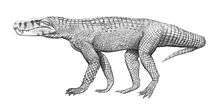Baurusuchus
Baurusuchus is an extinct member of the ancestral crocodilian lineage, which lived in Brazil from 90 to 83.5 million years ago, in the Late Cretaceous period. Technically, it is a genus of baurusuchid mesoeucrocodylian. It was a terrestrial predator and scavenger, about 3.5 to 4 metres (11.5 to 13.1 ft) long and 80 kilograms (176 lb) in weight.[1] Baurusuchus lived during the Turonian to Santonian stages of the Late Cretaceous Period, in Adamantina Formation, Brazil.[2] It gets its name from the Brazilian Bauru Group ("Bauru crocodile"). It was related to the earlier-named Cynodontosuchus rothi, which was smaller, with weaker dentition.[3] The three species are B. pachechoi, named after Eng Joviano Pacheco, its discoverer,[4] B. salgadoensis (named after General Salgado County in São Paulo, Brazil)[5] and B. albertoi (named after Dr. Alberto Barbosa de Carvalho, Brazilian paleontologist).[2] The latter species is disputed (see phylogeny section). Its relatives include the similarly sized Stratiotosuchus from the Adamantina Formation, and Pabweshi, from the Pakistani Pab Formation.
| Baurusuchus | |
|---|---|
_1.jpg) | |
| Skull of Baurusuchus salgadoensis | |
| Scientific classification | |
| Kingdom: | Animalia |
| Phylum: | Chordata |
| Class: | Reptilia |
| Clade: | †Sebecosuchia |
| Family: | †Baurusuchidae |
| Subfamily: | †Baurusuchinae |
| Genus: | †Baurusuchus Price, 1945 |
| Species | |
Paleoecology

B. salgadoensis is seen as a terrestrial predator, living in a hot and arid climate. The position of the external nares was unsuited for an amphibious lifestyle like in modern crocodilians and the snout and teeth are laterally compressed like in theropods. Both of this supports the terrestrial hypothesis. The hot environment hypothesis is based on the lifestyle of modern crocodilians and the stratigraphy of Baurusuchus. B. salgadoensis was found in fine massive sandstones which are interpreted as a floodplain area in hot and arid climate. Baurusuchus was likely able to dig holes for finding water in dry seasons or, like modern alligators do, for thermoregulation. The occurrence of very complete skeletons in correlated stratigraphic levels supports this. Such a strategy would have made it less water-bound than most modern crocodiles, allowing it to live in more continental climate. The strongly bent pterygoids suggest a powerful bite and that Baurusuchus could close its jaw very quickly. The skull and tooth morphology indicates that the biting strategies of Baurusuchus were similar to a Komodo dragon which include ambushing the prey, biting it and pulling back the serrated, blade-like teeth. Baurusuchus likely played an important role in its ecosystem, competing with the abelisaurids for food.[5]
Classification

Baurusuchus is the type genus of the family Baurusuchidae, a family consisting of crocodilians with elongated and laterally compressed skulls.[4] Other members of that family from the Cretaceous of South America include Stratiotosuchus and Cynodontosuchus, but baurusuchids are also known from the Cretaceous of Asia (Pakistan) and the Tertiary of Europe.[5]
A study in 2011 erected a new subfamily called Baurusuchinae. Seven diagnostic features for the group were described which include the moderate size and the broad frontals. The paper referred only Stratiotosuchus maxhechti and Baurusuchus to the subfamily, making Stratiotosuchus Baurusuchus' closest relative so far.[6] However, a study in the year 2014 referred a new species called Aplestosuchus sordidus to the subfamily, but supported a closer relationship of Baurususchus with Stratiotosuchus than with it. The species B. albertoi is an exception. The paper does not support its affiliation to Baurusuchus and views it as a close relative of Aplestosuchus. This is the cladogram they presented:[7]
| |||||||||||||||||||||||||||||||||||||||||||||||||||||||||||||||||||||||||
Sources
- In the Shadow of the Dinosaurs: Early Mesozoic Tetrapods by Nicholas C. Fraser and Hans-Dieter Sues
- The Osteology of the Reptiles by Alfred Sherwood Romer
References
- "Baurusuchus - paleofiles.com".
- Paulo Miranda Nascimento & Hussam Zaher (2010). "A new species of Baurusuchus (Crocodyliformes, Mesoeucrocodylia) from the Upper Cretaceous of Brazil, with the first complete postcranial skeleton described from the family Baurusuchidae" (PDF). Papéis Avulsos de Zoologia. 50 (21): 323‑361. doi:10.1590/s0031-10492010002100001.
- Bonaparte, Jose F. (1996). "Cretaceous tetrapods of Argentina". Muncher Geowissenschaften, Abhandlungen. 30: 73–130.
- Price, L.I. (1945). "A new reptile from the Cretaceous of Brazil". Departamento Nacional da Produção Mineral, Notas Preliminares e Estudos. Rio de Janeiro. 25: 1–8.
- Carvalho; Campos, Antonio; de Celso, Arruda; Nobre, Pedro Henrique (2005). "Baurusuchus salgadoensis, a new Crocodylomorpha from the Bauru Basin (Cretaceous), Brazil" (PDF). Gondwana Research. Japan: International Association for Gondwana Research. 8 (1): 11–30. doi:10.1016/S1342-937X(05)70259-8. ISSN 1342-937X.
- Felipe C. Montefeltro; Hans C. E. Larsson; Max C. Lange (2011). "A New Baurusuchid (Crocodyliformes, Mesoeucrocodylia) from the Late Cretaceous of Brazil and the Phylogeny of Baurusuchidae". PLOS ONE. 6 (7): 1–26. doi:10.1371/journal.pone.0021916. PMC 3135595. PMID 21765925.
- Godoy PL, Montefeltro FC, Norell MA, Langer MC (2014). "An Additional Baurusuchid from the Cretaceous of Brazil with Evidence of Interspecific Predation among Crocodyliformes". PLOS ONE. 9 (5): 1–12. doi:10.1371/journal.pone.0097138. PMC 4014547. PMID 24809508.